Discovering Dubai's Fish Roundabout: A Deep Dive
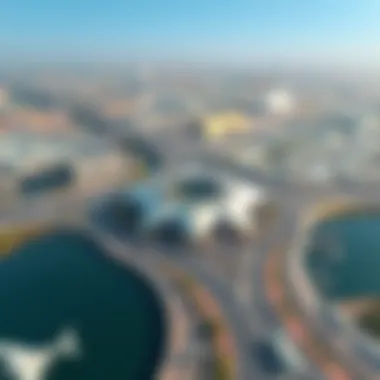
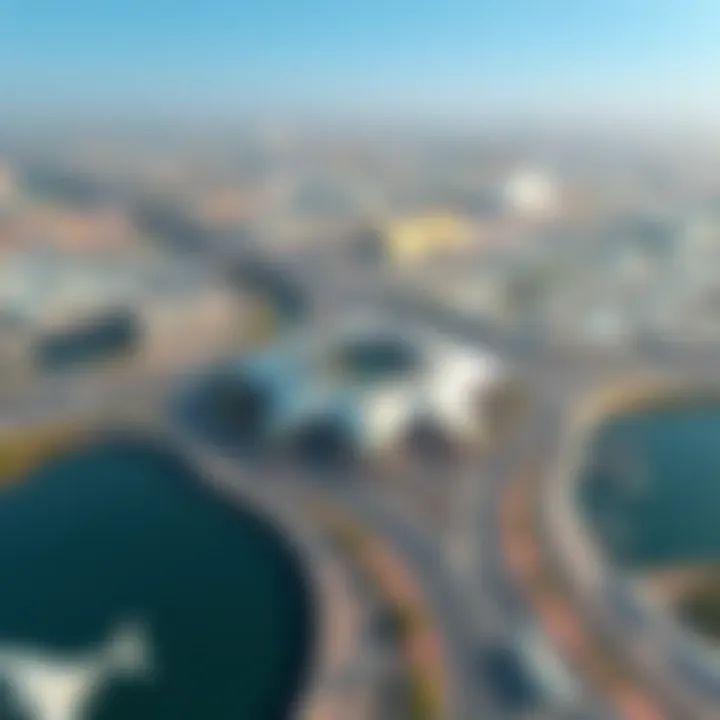
Intro
Dubai’s urban landscape is a tapestry woven with landmarks that capture the spirit and ambition of the city. Among them, the Fish Roundabout stands out as more than just a traffic junction; it is a symbol of the region’s growth and dynamism. Initially built to relieve congested roadways, it has transformed into a pivotal point for both locals and tourists, showcasing the unique interplay of modern architecture and cultural heritage.
Nestled in the heart of Dubai, this roundabout features a striking fish sculpture at its center, heralding the importance of fishing in the region’s history. In this article, we will traverse through its historical significance, examine its architectural nuances, and explore its substantial influence on local traffic patterns and commerce. Investors, agents, and expatriates alike will find this comprehensive overview a valuable resource, shedding light on why the Fish Roundabout is not to be missed when exploring the city's rich urban fabric.
With this backdrop laid, let’s take a closer look at Industry Insights related to the Fish Roundabout.
Historical Background
Understanding the historical background of the Fish Roundabout in Dubai is key to appreciating its significance in the urban framework of the city. The origins and subsequent evolution of this landmark reveal not only the architectural ambitions of Dubai but also shed light on the socio-economic transformations over the years.
Origins of the Fish Roundabout
The Fish Roundabout was established in the late 1980s, during a period when Dubai was rapidly emerging as a bustling trade hub and tourism destination. Originally, the roundabout was designed to enhance traffic flow in a growing urban area. But beyond the practicalities, it was conceived as a vibrant symbol of the city’s fishing heritage. The large sculpture of a fish at the center was more than just a decorative piece; it represented the rich maritime culture integral to the communities around the Arabian Gulf.
In the early 1990s, as infrastructure developments boomed, the roundabout became a focal point for both locals and visitors. The initial vision of the Fish Roundabout marked the start of a journey towards creating a city environment that balances modernity with cultural nods to its historical roots. The attention it received laid the groundwork for further advancements in urban planning and public art, making it an integral part of Dubai's landscape.
Evolution Over the Years
As the decades rolled on, the Fish Roundabout has undergone significant transformations. By the early 2000s, with the wave of real estate developments and urban expansion, the roundabout found itself in a changing context amidst high-rise buildings and prosperous commercial areas. Its role injected a sense of community reflection and served as an emblem of the city’s growth.
Upon evaluating the urban integration of the Fish Roundabout, it's stunning to see how it has adapted alongside Dubai's dynamism.
- Development Projects: Each phase of urban expansion influenced the aesthetics and functionality of the roundabout. Projects aimed at improving accessibility and showcase public art have consistently adapted the space to the public's needs.
- Cultural Touchpoints: Annual festivals and events in the nearby areas have helped the roundabout maintain relevance, showcasing how it blossomed from a mundane traffic solution into a beacon of local culture.
- Enhanced Design: Over the years, the architecture surrounding the roundabout has been enhanced with extensive landscaping, creating an inviting environment for pedestrians and drivers alike.
The Fish Roundabout, thus, stands not just as a traffic hub but as a narrative of Dubai's journey, intertwining its historical roots with a clear vision for the future. As Dubai continues to evolve, so too will the Fish Roundabout, firmly anchoring its place in the story of this vibrant city.
Architectural Features
The architectural features of the Fish Roundabout in Dubai contribute significantly to its stature as a prominent urban landmark. This section delves into the key design elements and artistic installations that embellish the roundabout, shedding light on their relevance both to the aesthetic appeal and functionality of this space.
Design Elements
At the core of the Fish Roundabout's charm lies its intricate design elements, which serve not only a visual purpose but also a functional one. The roundabout is framed by a distinctive fish sculpture, symbolizing Dubai's rich maritime heritage. This iconic design captures the essence of the city’s connection with the sea, making it a popular spot for photography and a cultural beacon for both locals and tourists.
The use of curved roadways around the roundabout enhances the flow of traffic, minimizing bottleneck situations that are common in traditional intersections. The thoughtful engineering design allows for a smooth transition for vehicles, facilitating easier movement while maintaining safety for pedestrians crossing the plaza.
Moreover, the surrounding landscaping employs native plants that help to create a green belt around the roundabout. This incorporation of sustainable practices reflects a movement towards greener urban spaces in Dubai, ensuring that the architecture harmonizes with nature rather than overpowering it.
Artistic Installations
Once you step into the realm of the Fish Roundabout, it's hard to miss the captivating artistic installations that adorn it. The centerpiece, the giant fish sculpture, is not just a random decoration; it tells a story about the importance of fishing to Dubai’s history and economy. Crafted with meticulous care, the sculpture stands as a reflection of the craftsmanship and creativity that the UAE is known for.
Beyond mere decoration, these installations serve as conversation starters. Many social media posts highlight the vibrancy and uniqueness of this landmark. A visitor might remark, *"You haven’t really experienced Dubai until you’ve marveled at the Fish Roundabout’s stunning artwork—such an emblematic piece!"
In addition, periodic art exhibitions or installations keep the area dynamic, engaging the community and offering local artists a platform to showcase their work. This constant evolution brings life to the roundabout, allowing it to grow and change with the cultural landscape of Dubai.
"Art is the most beautiful of all lies. Through it, the Fish Roundabout narrates a story that is both contemporary and rooted in history."
In summary, the architectural features of the Fish Roundabout blend functionality with artistry. Investors and visitors alike recognize it not just as a thoroughfare but as an integrated piece of Dubai’s urban identity. As the city continues to grow and evolve, the designs and installations at the Fish Roundabout will likely keep pace, becoming ever more intricate and meaningful.
Traffic Dynamics
The dynamics of traffic around the Fish Roundabout hold significant weight in understanding the flow and management of transportation in Dubai. It's not just about the roundabout itself; it serves as a pivotal connection to various districts in the city. As a bustling intersection, it plays a crucial role in the daily commutes of locals and visitors alike. A smooth traffic dynamic can enhance the efficiency of the urban landscape, while congestion can have a ripple effect on surrounding areas.
Traffic Flow Patterns
Examining the traffic flow patterns around the Fish Roundabout reveals some intricate details about how vehicles and pedestrians interact with this landmark. The roundabout is designed to facilitate a constant flow of vehicles, minimizing the need for stopping and preventing bottlenecks. This strategic design is especially beneficial during peak hours when the roads are filled with commuters.
- Peak Hours: Mornings see a surge of traffic as individuals rush to work, while evenings bring another wave as people head home. On weekends, the traffic becomes more variable with tourists enjoying the area.
- Vehicle Types: The roundabout experiences a diverse mix of vehicles, from private cars to buses and trucks. Each type of vehicle has its own impact on the flow, necessitating careful management to maintain order.
- Pedestrian Movements: Foot traffic is also a significant factor. The presence of crossings and pedestrian signals has to be harmonized with vehicle flow to ensure safety while enabling efficient movement.
Utilizing technologies like smart traffic lights and real-time monitoring can optimize traffic flow, reducing wait times and enhancing safety.
Impact on Local Commute
The Fish Roundabout does more than just serve as a traffic junction; it heavily influences local commuting patterns. The strategic location of the roundabout makes it essential for connecting various major roads. How people navigate this space can determine the speed and efficiency of their commutes.
- Time Efficiency: For many residents, a clear and well-managed roundabout directly translates into shorter travel times. A well-functioning roundabout helps them minimize frustrations during their daily travels.
- Accessibility: The roundabout’s design facilitates various routes that lead to popular destinations, including shopping centers and business districts, enhancing the accessibility of these areas for both expatriates and locals.
- Public Transport Integration: Buses and taxis frequently use this roundabout, making it a hub for public transport. Its operation impacts not just individual drivers but also those relying on communal transport systems. Efficient management in this regard can lead to better public transport usage and satisfaction among commuters.
The Fish Roundabout serves as more than just a roundabout; it encapsulates the very essence of Dubai's rapid urban mobility and development.
Understanding these dimensions of traffic dynamics is vital for anyone interested in the Fish Roundabout, especially investors and businesses looking to capitalize on the economic activities surrounding it. With the right insights, stakeholders can make informed decisions that align with the current trends in urban traffic management.
Surrounding Attractions
The Fish Roundabout in Dubai is not merely a transitional point for vehicles; it's a vibrant hub surrounded by various attractions that play a significant role in the life of the city. This section reflects on the importance of these surrounding areas, revealing why they are essential for visitors, residents, and investors alike. The atmosphere induced by the nearby attractions contributes greatly to the roundabout’s popularity.
Nearby Dining and Shopping
The area surrounding the Fish Roundabout boasts an impressive variety of dining and shopping options. From high-end restaurants to local eateries, the options truly cater to every palate. Dining establishments like Al Fanar Restaurant offer a taste of Emirati cuisine, allowing diners to relish local flavors in a warm setting. For those craving international fare, choices abound, featuring everything from Italian to Indian cuisines.
Shopping enthusiasts will find themselves at home too; the roundabout's proximity to The Dubai Mall and the more localized markets makes it a convenient hub to shop for souvenirs or luxury goods.
- Key highlights:
- Multiple dining options from casual to fine dining.
- Access to both local and international brands.
- Open daily, ensuring availability for last-minute shoppers or late-night diners.
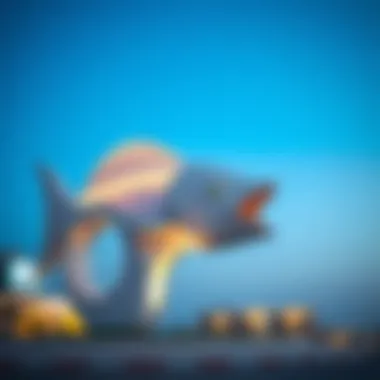

This variety makes the Fish Roundabout not just a traffic focal point but also a culinary and shopping destination.
Cultural Significance of the Area
The surroundings of the Fish Roundabout embody Dubai's rich cultural tapestry. Several cultural institutions, such as the Dubai Aquarium and Underwater Zoo located in The Dubai Mall, further enhance the area’s appeal, showcasing the blend of modernity with cultural heritage. The roundabout not only serves as a landmark but also stands as a symbol of Dubai’s growth and ambitions.
Moreover, the presence of art installations and sculptures in the vicinity adds to the cultural experience, inviting both critique and admiration. Visitors can take a leisurely stroll to appreciate the showcased talents of local artists, which reflect aspects of Emirati life and tradition. This interplay of culture and commerce nurtures a unique environment suitable for both tourists and locals.
- Cultural consideration:
- Events held regularly at nearby venues, bringing the community together.
- Artistic showcases aimed at celebrating local talent and heritage.
- Educational opportunities through cultural institutions, enhancing tourism.
The Fish Roundabout, with its surrounding attractions, not only aids in navigating the bustling city but also immerses individuals in Dubai's rich culture and culinary delights.
Economic Impact
The economic ramifications of the Fish Roundabout extend beyond simple traffic management; it resonates deeply within the local economy of Dubai. This central junction acts as a crucial nexus for businesses, vendors, and real estate interest, blending urban functionality with commercial prosperity. It plays a pivotal role in the growth of various sectors by enhancing accessibility and visibility for local enterprises, thereby influencing investment decisions.
The Fish Roundabout not only serves as a thoroughfare but is also a significant landmark that draws visitors and residents alike. Its design invites attention, making it an attractive spot for businesses seeking foot traffic. Restaurants, retail shops, and service-oriented establishments thrive in this area, benefiting from the constant influx of bystanders and passersby, which ultimately boosts their bottom line.
Influence on Local Businesses
Local businesses around the Fish Roundabout find themselves in a prime position to leverage the unique traffic that flows through. Whether it’s a small artisan bakery or a large chain store, the visibility and accessibility offered here can lead to substantial sales growth. The roundabout functions nearly like a marketplace, where consumers are drawn to the variety available in the vicinity. Owners often note a marked difference in customer engagement and sales volume, especially during peak hours.
- Accessibility: With numerous routes converging at this junction, it’s easier for customers to reach businesses from different parts of the city.
- Visibility: The surrounding landscape is littered with modern structures and advertisement displays, making it hard for potential customers to ignore the business enticing their attention.
That said, it's also worth mentioning that businesses often invest in marketing and branding strategies aimed specifically at capturing this unique audience. Given its high-traffic nature, effective marketing here requires creativity. For instance, placing eye-catching signs or facilitating events can attract even more visitors, turning curious passersby into loyal customers.
Real Estate Development in Proximity
The Fish Roundabout has largely influenced real estate development in its immediate surroundings. Developers are very keen on the plots of land adjacent to this area, as they recognize that proximity to such a well-trafficked spot can amplify property values rapidly. Many new ventures and residential properties are popping up as developers seek to capitalize on the ongoing demand for both commercial and residential spaces.
- Value Appreciation: Locations near the roundabout have shown considerable appreciation in property values, making them attractive for both buyers and investors.
- Mixed-Use Developments: Many projects incorporate mixed-use strategies, combining residential spaces with commercial entities, effectively creating vibrant communities.
As urban planners and real estate investors watch closely, it becomes evident that this intersection is not just another roundabout; it serves as a vital component of Dubai’s urban fabric, blending commerce, culture, and community. Investing in properties nearby could prove fruitful as the Fish Roundabout continues to evolve alongside the city's growth.
"The Fish Roundabout isn't just a place where roads meet; it's where opportunities converge."
Future Developments
As Dubai continues to grow and transform, the Fish Roundabout remains a crucial focal point for urban planning and development. This section explores the anticipated developments surrounding the roundabout, highlighting not just the scope of impending initiatives but also their potential benefits and the critical considerations that investors and stakeholders must keep in mind.
Urban Planning Initiatives
Urban planning in and around the Fish Roundabout is driven by the need to harmonize the area with Dubai's rapid infrastructural advancements. I think it's like a chess game; strategizing moves is important. Future plans may involve the integration of multi-functional spaces around the roundabout that combine residential, commercial, and recreational facilities. This type of mixed-use development aims to create a vibrant, self-sufficient community, allowing residents and visitors easier access to amenities without having to travel far.
- More pedestrian-friendly walkways could be developed to enhance safety and connectivity.
- Bicycle lanes are also a consideration, promoting sustainable transport options.
- Green spaces might be expanded, aligning with Dubai’s commitment to increasing urban greenery and combating the heat.
These changes aim to create a synergy between the newly planned structures and the established characteristics of the Fish Roundabout. Moreover, community input is critical; planners often engage local residents and businesses to gather feedback that will shape these initiatives into something truly beneficial for the neighborhood.
Projected Traffic Management Solutions
Traffic congestion around the Fish Roundabout has long been a concern for commuters. To alleviate this issue, projected traffic management solutions are pivotal. The authorities are likely to examine technology-driven systems that could optimize traffic flow.
Possible Initiatives May Include:
- Smart Traffic Lights: Adjusting signal timings in real-time based on traffic conditions, minimizing waiting times.
- Dedicated Bus Lanes: These lanes would help streamline public transit, encouraging more people to use buses instead of personal vehicles. This not only reduces congestion but also promotes eco-friendliness.
- Enhanced Signage and Information Systems: Providing real-time traffic updates could help drivers make informed choices, reducing bottlenecks during peak hours.
Overall, addressing traffic concerns not only enhances the daily commutes for residents and visitors but also underpins the economic activity in the area, making the Fish Roundabout a more appealing spot for commercial investment and development.
"Sustainable urban designs and efficient traffic management are the building blocks of a thriving city."
Community Perspectives
Understanding community perspectives on the Fish Roundabout in Dubai sheds light on the profound impact this landmark has on the local population as well as visitors. The Fish Roundabout is not just a transit point; it's a gathering place, a symbol of the city's vibrancy, and a reflection of the community's identity. Examining both local residents' and visitors' views provides insight into how this infrastructure influences daily life, traffic, and social interactions in the heart of Dubai.
Local Resident Opinions
When you chat with residents, the sentiment runs deep. Many locals see the Fish Roundabout as a staple of their daily routines. It's a familiar landmark that helps people navigate the bustling streets of Dubai. While some may grumble about traffic congestion during peak hours, the sentiment largely leans towards appreciation. They often remark that it adds a unique character to the area.
A resident might say, "I grew up here; the Fish Roundabout is like an old friend you bump into all the time." Such statements highlight how ingrained this feature is in the lives of the community.
The roundabout is also a point of cultural pride. Each monument and fish sculpture tells a story, symbolizing the local fishing heritage that dates back generations. The fellow locals often engage in conversations about their experiences and associations with the roundabout, often recalling nostalgic memories linked with family gatherings or significant life events occurring nearby.
Furthermore, some community members have voiced concerns regarding the heavy traffic flow and pedestrian safety. They express a desire for improved infrastructure around the roundabout to enhance safety for both drivers and pedestrians. This feedback is vital as it highlights a community actively participating in discussions about urban development, reflecting their growth aspirations and concerns.
Visitor Experiences
Visitors to the Fish Roundabout often perceive it through a different lens. For many, it serves as a delightful introduction to Dubai's distinct charm. Tourists frequently snap photos in front of the iconic fish sculptures, creating memories that intertwine their travels with the city's culture. Typical feedback might include how unexpectedly beautiful the roundabout is, especially when lit up at night.
From a visitor's perspective, the roundabout acts as both a navigational point and a picturesque spot to appreciate the vibrant Dubai environment. Many individuals remark on how efficient the overall transport system is, with many popular destinations within a short drive.
On online platforms such as TripAdvisor and Reddit, you can find reviews detailing experiences ranging from “a must-see” to “not worth the detour” depending on their individual expectations and travel itineraries. Hence, the opinions vary significantly, depending on the visitors’ purpose for being in Dubai.
The Fish Roundabout is an emblem of community coherence and a bridge connecting the daily lives of residents to the explorations of visitors.
The juxtaposition of local and visitor perspectives offers valuable insights for businesses and urban developers alike. Understanding these dynamics can inform better urban planning and tourism strategies that resonate with both the local community and the transient population eager to experience Dubai's charm. By taking into account diverse viewpoints, stakeholders can enhance the experience for everyone involved, ensuring that the Fish Roundabout evolves as a beloved feature of Dubai’s urban landscape.
Environmental Considerations
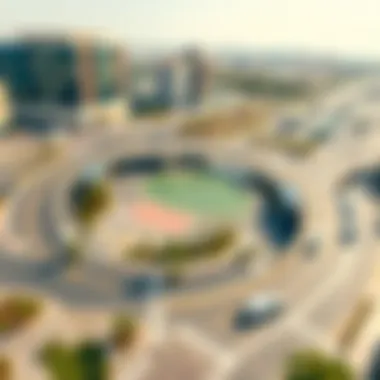
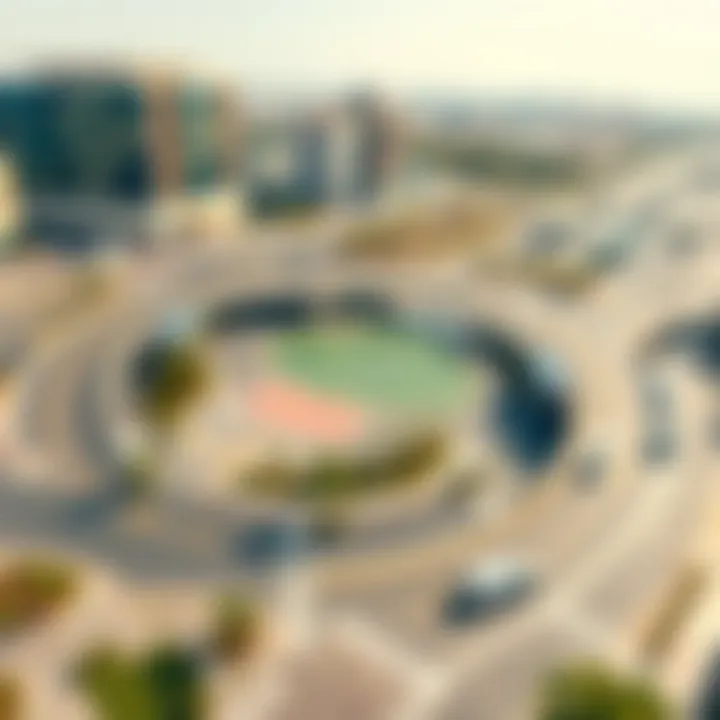
In understanding the Fish Roundabout’s role in Dubai, it's essential to consider the environmental aspects that contribute not only to the beauty of the area but also to the overall urban ecosystem. These considerations have become increasingly crucial as cities around the globe strive for sustainability. Dubai, known for its rapid development, is also embracing the need for greener solutions. The Fish Roundabout is not just a traffic hub; it reflects how environmental factors intertwine with urban design and public spaces.
Sustainability Efforts
The commitment to sustainability around the Fish Roundabout manifests in several compelling initiatives. Firstly, the roundabout has adopted practices aimed at reducing carbon footprints. For instance, the installation of energy-efficient LED lighting has illuminated the area while conserving energy.
- Public Transport Usage: Enhancing metro and bus services encourages residents and visitors to opt for public transport rather than personal vehicles. This switch reduces traffic congestion and decreases pollution levels, promoting cleaner air quality in the area.
- Green Building Standards: Nearby developments are often constructed adhering to sustainability standards outlined by the Dubai Green Building Code. This focuses on efficient resource use and minimization of waste during construction.
- Community Awareness: Various advocacy campaigns highlight environmental practices to visitors and residents alike. This engagement cultivates a community that values environmental responsibility.
These efforts collectively signify that environmental considerations can significantly enhance the beauty and functionality of urban spaces like the Fish Roundabout.
Green Spaces Around the Roundabout
Another vital element to consider is the incorporation of green spaces surrounding the Fish Roundabout, which brings numerous benefits to the urban landscape. These areas not only beautify the environment but also improve the quality of life for those in proximity. The green spaces offer:
- Recreational Areas: With benches, walking paths, and lush vegetation, these spaces provide locals and tourists with a place to unwind amidst the fast-paced city life. Families can enjoy picnics, joggers can find room to stretch their legs, and nature enthusiasts can revel in the beauty of flora endemic to the region.
- Biodiversity: By featuring native plants and sometimes small wildlife habitats, these spaces promote biodiversity. It helps support various species that play crucial roles in maintaining ecological balance.
- Air Quality Improvement: Vegetation acts as a natural air purifier. Plants absorb CO2 and produce oxygen, contributing to healthier air in an often-busy area.
The Fish Roundabout's green spaces serve to illustrate how urban planning doesn’t have to come at the expense of nature. Instead, it can promote harmony, creating a richer environment for both people and wildlife.
Transportation Links
Transportation Links play a vital role in shaping urban environments, particularly in bustling metropolises like Dubai. The Fish Roundabout, as a key hub, serves as a connective tissue between various modes of transport, streamlining movement around the city. Understanding these links not only reveals the importance of the roundabout within the urban fabric but also highlights its influence on economic activity and accessibility.
Metro Connectivity
The Dubai Metro is more than just a transportation system; it's a lifeline for many residents and visitors. Closest to the Fish Roundabout is the Ras Al Khor Metro Station, situated a short distance away. This connectivity offers commuters a way to bypass surface traffic, providing a fast and efficient alternative. The red line of the Metro system ensures that travelers can reach significant parts of the city, including Downtown Dubai and the airport, without hassle.
- Benefits of Metro Accessibility:
- Reduces dependency on personal vehicles, leading to less congestion.
- Increases foot traffic around the Fish Roundabout, benefiting local businesses.
- Promotes eco-friendly travel choices among residents and tourists.
For expatriates and investors, being near a Metro link enhances property value and desirability. The ease of travel not only appeals to individuals moving to the city but also investors looking to capitalize on emerging neighborhoods around transit hubs.
Bus Routes and Accessibility
The bus system in Dubai complements the Metro, offering a comprehensive network that connects neighborhoods to major transit points like the Fish Roundabout. Several bus routes traverse this junction, creating a seamless flow for commuters. Buses arrive regularly, making it easy for users to plan their journeys with confidence.
- Key Considerations:
- Accessibility for individuals with disabilities is catered for, ensuring that everyone can benefit from public transport.
- Buses facilitate access to nearby shopping areas, cultural landmarks, and residential districts, enhancing the appeal of the Fish Roundabout.
- Integrated ticketing with Metro makes transfers straightforward and economical.
In summary, solid transportation links are not just a matter of convenience but are also fundamental to the sustainable growth of the area surrounding the Fish Roundabout. Investors keen on the real estate market in Dubai should pay close attention to the effectiveness of these links, as they can influence property values and overall urban quality of life.
"Having robust transport links is crucial for any urban area, contributing to the dynamic nature of cities and enhancing livability."
For more information on the Dubai Metro, refer to Dubai Metro.
For exploring bus services available in Dubai, the official RTA
Historical Landmarks in Proximity
The Fish Roundabout stands not merely as a point of convergence in Dubai's urban landscape but also as a cornerstone for a rich tapestry of historical landmarks. Understanding these adjacent sites enhances our appreciation for the city's heritage and offers insights into the cultural pulse of the area.
Cultural Institutions
Several cultural institutions dot the vicinity of the Fish Roundabout, enriching the experience for both residents and visitors. These institutions serve not just as repositories of art and history but also as community hubs where knowledge and tradition intertwine.
For instance, the Dubai Museum is a stone's throw away, nestled in the Al Fahidi Fort, dating back to 1787. Its exhibits tell tales of the emirate's transformation from a small fishing village to a bustling metropolis. The museum’s interactive displays and traditional artifacts provide a vibrant look at the cultural heritage of Dubai.
Additionally, the Sheikh Mohammed Centre for Cultural Understanding promotes knowledge and intercultural dialogue, hosting open discussions and cultural experiences. Visitors can immerse themselves in local customs, participate in traditional meals, and understand the fundamental principles of Emirati life.
The proximity of these cultural institutions to the Fish Roundabout bolsters the area's appeal, drawing in cultural enthusiasts and boosting local tourism, which in turn attracts investors looking to capitalize on the rise in visitor footfall.
Monuments and Memorials
In close proximity to the Fish Roundabout, one can find significant monuments and memorials that mark pivotal moments in Dubai’s history. These sites tell stories of resilience and pride, providing visual cues to the journey of this remarkable city.
Among the prominent monuments is the Al Gaffal Monument, a tribute to the pearling industry that was once the backbone of Dubai’s economy. Its intricate design reflects the craftsmanship of the era, and it serves as a reminder of the city’s maritime heritage, which has significantly influenced its growth.
Another noteworthy site is the Martyrs' Monument, embodying the Emirati people's valor and commitment. This monumental structure honors the sacrifices made by those who served in the line of duty. Standing tall, it fosters a sense of national pride, resonating deeply with residents and visitors alike.
These monuments not only serve as historical reminders but also as focal points for community gatherings, thereby enhancing the social fabric of the area. They create a layered understanding of local identity, which becomes an attractive prospect for investors and stakeholders looking to engage with Dubai's evolving narrative.
"Cultural landscapes are not mere backdrops; they are dynamic dialogues reflecting the lives of those who inhabit these spaces."
Engaging with the historical landmarks surrounding the Fish Roundabout offers a distinct perspective on the city’s evolution and cultural narrative. Their relevance goes beyond tourism; they establish a thematic connection that resonates within real estate development, attracting businesses and individuals eager to be part of Dubai’s story.
The Role of Fish Roundabout in Dubai's Identity
The Fish Roundabout serves as more than just a point of convergence for traffic in Dubai; it's a symbol, a cultural touchstone that encapsulates the spirit and growth of the city. Integral to the urban landscape, the roundabout not only facilitates movement but also represents the rich heritage and contemporary aspirations of Dubai. It’s a portal of sorts, bridging the past and future, where traditional values meet modern ambitions.
Symbolism and Cultural Representation
At its core, the Fish Roundabout has evolved into a potent symbol of Dubai’s maritime heritage, reflecting the historical significance of the fishing industry in the region’s development. The iconic fish sculpture stationed at the center serves as a reminder of the city's roots, reminding all who pass through of the vital role that fishing played before Dubai transformed into the dazzling metropolis it is today.
Additionally, the roundabout signifies the prosperity that the fishing industry once brought to local communities, functioning as a bustling center for trade and social interaction. This heritage is essential for investors and residents alike, drawing attention to how the past informs the present.
Moreover, the architectural design of the roundabout and surrounding features play a crucial role in public sentiment. The integration of artistic installations enriches the site, attracting visitors and locals. These elements not only beautify the area but also serve as focal points for cultural events and community gatherings, fostering a sense of belonging and collective identity among residents.
Public Sentiment and Recognition
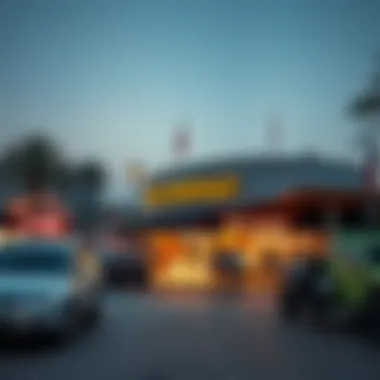
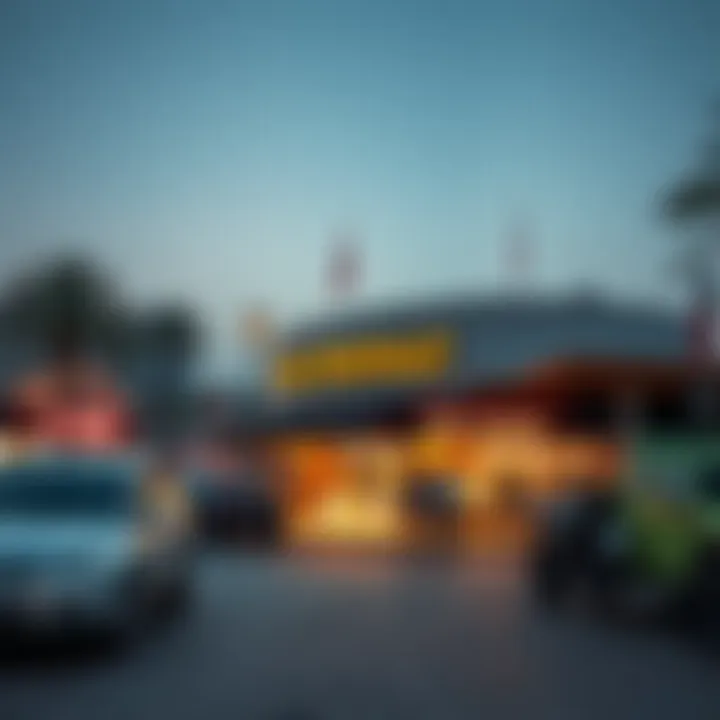
There is a palpable affection for the Fish Roundabout among locals, showcased through various informal surveys and community discussions. Many see it as a beloved landmark that encapsulates the essence of Dubai. The roundabout is frequently mentioned in conversations, social media posts, and even in regional art, highlighting its status as an integral part of daily life.
While its utilitarian function is recognized, the emotional connection that people feel toward this site is equally significant. Visitors often remark on the roundabout's beauty and charm, with some even identifying it as a must-visit spot for capturing the spirit of the city. Aspects like the vibrant design and surrounding amenities make it a cherished location for both tourists and long-time residents.
This emotional resonance is vital for real estate professionals seeking to understand investor sentiments and market trends in the area. By recognizing the significance of such landmarks, potential investors can appreciate why areas surrounding the Fish Roundabout are not just prime for business but also revered spaces for community engagement.
In summary, the Fish Roundabout stands as a testament to Dubai's past while actively shaping its present and future identity. It's not merely a traffic circle; it symbolizes community, history, and an evolving vision that continues to capture the hearts and minds of those who encounter it.
Visitor Information
Understanding the visitor information related to the Fish Roundabout is crucial for anyone planning to engage with this landmark. The roundabout is not only a vital traffic intersection but also a critical node for social and commercial activity. Hence, knowing how to access it and the ideal times to visit enhances the overall experience. This section provides insights into how to navigate this area conveniently and optimally for both local residents and tourists.
Access and Directions
Reaching the Fish Roundabout is pretty straightforward, as it resides in the heart of Dubai. Situated near the critical intersection of Sheikh Zayed Road and Al Maktoum Road, the roundabout is easily accessible via several modes of transport. Here’s how one can get there:
- Driving: If you’re behind the wheel, simply use a map application, and you’ll receive turn-by-turn direction. Parking spaces can be a bit of a hassle, especially during peak hours, so arriving early is a smart choice.
- Public Transport: The Dubai Metro is a convenient option. You can hop on at a neighboring station, such as Khalid Bin Al Waleed or Al Ras. After reaching your stop, local taxis or service buses can connect you directly to the roundabout.
- Walking: If you're exploring nearby attractions on foot, you might find yourself enjoying a pleasant stroll to the roundabout from hotels or shopping centers located close by.
Knowing the various available routes saves time and can help avoid the less-than-stellar traffic flow that sometimes plagues this area. Make it a point to consider real-time traffic updates for the most efficient travel.
Best Times to Visit
Choosing the right time for your visit can really make a difference in the whole experience around the Fish Roundabout. Time of day can affect not only crowds but also the beauty of the surroundings. Here are a few tips:
- Early Mornings: If you’re an early bird, visiting in the morning can provide a serene atmosphere. The light at dawn casts a beautiful glow on the installations around the roundabout. Fewer people around allow for peaceful observation.
- Late Afternoons: As the sun sets, the roundabout becomes even more picturesque, with lights that enhance the architectural features. This is when many people come out to capture perfect photos, so despite higher foot traffic, the ambiance is enchanting.
- Weekdays vs Weekends: Weekdays tend to be quieter in general compared to weekends when both locals and tourists flock to the area. If you prefer less crowd, aim for a weekday visit if your schedule permits.
Ultimately, factors like local events or public holidays can affect the foot traffic and overall ambiance, so a bit of prior research goes a long way.
"Planning ahead is half the battle won. Knowing when and how to visit helps make the most out of any experience."
In summary, focusing on visitor information helps you sidestep common pitfalls of urban exploration, ensuring your trip is both rewarding and enjoyable.
Safety and Regulations
In any urban landscape, the nuances of safety and regulations play a pivotal role. This holds particularly true for the Fish Roundabout in Dubai, which serves as a critical junction in the metropolitan area. Understanding the frameworks that govern this site is essential for several reasons, ranging from traffic management to ensuring a secure environment for all who navigate its roadways. When considering investments in real estate or local businesses, a profound grasp of safety measures and regulatory frameworks can significantly influence decision-making and future growth potential.
Traffic Safety Measures
Safety at the Fish Roundabout is not just a mere checkbox; it’s an intricate layer in the daily rhythm of traffic flow. Several measures are implemented to maintain peace and security:
- Traffic Signals and Signage: Advanced traffic lights and clear signage guide vehicles, helping to prevent accidents. This is especially crucial in a city like Dubai, where high-density traffic can become chaotic.
- Pedestrian Crossings: Well-marked pedestrian paths ensure that foot traffic can navigate safely without entering the flow of vehicles. These crossings are strategically placed at high traffic areas, reducing potential hazards.
- Surveillance Cameras: The presence of CCTVs acts as a deterrent to reckless driving and promotes adherence to traffic rules. They also provide real-time monitoring that can help law enforcement respond swiftly to incidents.
- Regular Inspections: Authorities conduct routine inspections of the roundabout's infrastructure to identify and rectify potential safety issues.
The multitude of measures not only aids in preventing accidents but also fosters a sense of safety among locals and tourists alike, making the roundabout a more attractive area for business and leisure activity.
Regulatory Framework for Development
Regulations surrounding the Fish Roundabout’s development structure the continuum of its growth and adaptation. This framework is significant for several stakeholders, especially investors and urban planners. Here are key components of the regulatory setup:
- Building Codes: Strict adherence to building codes ensures that any new construction complements both the aesthetics and functionality of the roundabout. This is crucial in maintaining Dubai’s ambitious vision for modern architecture while respecting urban themes.
- Zoning Laws: Zoning laws dictate what kind of developments can occur around the roundabout. By delineating commercial, residential, and recreational zones, stakeholders can better understand the potential for various real estate investments.
- Environmental Regulations: As sustainability becomes a focal point globally, Dubai has enacted measures to ensure development projects support environmental conservation. This is especially vital around public spaces like the Fish Roundabout, where green spaces enhance the quality of life.
- Public Consultation Processes: Involving community perspectives during the planning stages ensures a sense of ownership among local residents. This strengthens community ties and can foster a supportive environment for new businesses.
The regulatory framework not only paves the way for thoughtful development but also protects the interests of investors, helping them navigate the complexities of urban growth. In summary, the balance of safety measures and regulatory oversight at the Fish Roundabout reflects its importance in Dubai’s evolving urban narrative.
"Safety is not just a matter of compliance; it is the foundation upon which communities thrive."
Through these lenses, it is evident that the Fish Roundabout is more than a passageway; it’s an integral part of Dubai’s identity, balancing commerce, culture, and community safety.
Tips for Investors
Investing in real estate around landmarks like the Fish Roundabout can be a profitable venture. This section sheds light on why the Fish Roundabout is not just a pretty roundabout, but a significant investment opportunity, thanks to its cultural, economic, and infrastructural positioning in Dubai.
Understanding Market Trends
Investors ought to keep their ear to the ground regarding market dynamics. The Fish Roundabout area is a flashpoint for growth and development, presentin g both challenges and opportunities.
- The increasing foreign investment in Dubai plays a crucial role; it makes the property around the roundabout highly attractive.
- These efforts are not just focused on residential properties but also commercial spaces, suggesting a shift in demand for areas surrounding significant landmarks.
- Stay informed with resources like the Dubai Land Department or Dubai Statistics Center to gauge trends.
Identifying trends could involve chatting with locals, following construction updates, or attending real estate expos that often feature Dubai’s booming market.
Key Considerations for Real Estate Investment
When it comes to making a real estate investment near the Fish Roundabout, certain factors loom large over less thoughtful, impulsive decisions. Understanding these can make all the difference.
- Location: Proximity to the Fish Roundabout enhances visibility and accessibility. This means both foot traffic and vehicle access remain high.
- Infrastructure Development: Keep an eye on upcoming infrastructure projects like new roads or public transport enhancements, as they can escalate property values swiftly.
- Regulatory Landscape: Always be aware of regulations. Familiarize yourself with Dubai’s real estate laws to ensure compliance, and steer clear of potential legal pitfalls.
- Visitor Demographics: The roundabout attracts both locals and tourists. Understanding who frequents the area can provide insight into potential demand for services or accommodations.
Overall, wise investing requires thorough research and anticipation of future developments. Always factor in potential risks, given market volatility.
"An informed investor is a successful investor. Do your homework before diving in."
Ending
The Fish Roundabout stands as a significant emblem in Dubai's urban tapestry, embodying a multitude of layers that range from historical, cultural, and economic aspects to infrastructure intricacies. Its importance cannot be understated, as it not only facilitates traffic flow but also serves as a vital point of convergence for various urban endeavors.
Summarizing Key Insights
In this article, we examined key facets of the Fish Roundabout that contribute to its prominence:
- Historical Roots: The roundabout's origins tie into Dubai’s development trajectory, marking a transition from a small trading port to a prime international hub. This history lends it both character and depth.
- Architectural Significance: Its design and artistic elements transcend mere functionality. The aesthetic appeal coupled with the fish sculpture itself resonates with local cultural identity, bridging tradition and modernity.
- Traffic Dynamics: The roundabout plays a crucial role in local transportation. Understanding its traffic dynamics is essential for anyone navigating this bustling metropolis.
- Economic Influence: Moreover, its influence on nearby businesses and real estate development underscores its economic importance, affecting local investments and the overall growth of the area.
- Community Views: Lastly, perspectives from the community—both locals and visitors—provide firsthand accounts that enrich the understanding of the roundabout's role in Dubai.
Future Perspectives for the Fish Roundabout
As urban planning evolves, the Fish Roundabout will likely witness transformative changes to accommodate growth and enhance its functionality. Potential future directions include:
- Adaptation to Technological Advancements: With smart city initiatives gaining traction, the integration of innovative traffic management systems could revolutionize how the roundabout operates.
- Increased Green Spaces: As emphasis on sustainability rises, there may be plans for more environmentally friendly zones around the roundabout, facilitating community engagement while enhancing aesthetic value.
- Cultural Events and Activities: There could be greater use of the area for cultural events, which not only bring life to the space but also fortify its significance in Dubai’s cultural calendar.
- Impact on Urban Connectivity: Ongoing improvements in public transport may redefine access to the roundabout, rendering it a critical node in the wider city network.
The future of the Fish Roundabout shines bright, poised to adapt and grow, ensuring it remains a focal point in the ongoing narrative of Dubai's urban journey.



